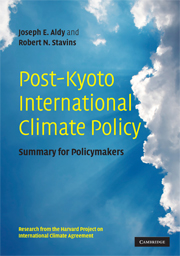Book contents
- Frontmatter
- Contents
- International Advisory Board, Harvard Environmental Economics Program
- Faculty Steering Committee, Harvard Project on International Climate Agreements
- Management, Harvard Project on International Climate Agreements
- List of Contributors
- Foreword by Timothy E. Wirth
- Chapter 1 Introduction and Overview
- Chapter 2 Lessons for the International Policy Community
- References
- Appendix 1 Summaries of Research Initiatives, Harvard Project on International Climate Agreements
- Appendix 2 Selected List of Individuals Consulted, Harvard Project on International Climate Agreements
- Appendix 3 Workshops and Conferences, Harvard Project on International Climate Agreements
- Appendix 4 Glossary and Abbreviations
Appendix 1 - Summaries of Research Initiatives, Harvard Project on International Climate Agreements
Published online by Cambridge University Press: 05 June 2012
- Frontmatter
- Contents
- International Advisory Board, Harvard Environmental Economics Program
- Faculty Steering Committee, Harvard Project on International Climate Agreements
- Management, Harvard Project on International Climate Agreements
- List of Contributors
- Foreword by Timothy E. Wirth
- Chapter 1 Introduction and Overview
- Chapter 2 Lessons for the International Policy Community
- References
- Appendix 1 Summaries of Research Initiatives, Harvard Project on International Climate Agreements
- Appendix 2 Selected List of Individuals Consulted, Harvard Project on International Climate Agreements
- Appendix 3 Workshops and Conferences, Harvard Project on International Climate Agreements
- Appendix 4 Glossary and Abbreviations
Summary
Overview
This proposal builds on the foundations of the Kyoto Protocol, but strengthens it in important ways. It attempts to solve the most serious deficiencies of Kyoto: the absence of long-term targets, the absence of participation by the United States and developing countries, and the lack of motivation for countries to abide by their commitments. Although there are many ideas to succeed Kyoto, virtually all the existing proposals are based either on science (e.g., capping global concentrations at 450 ppm) or on economics (weighing the economic costs of aggressive short-term cuts against the long-term environmental benefits). The plan for emissions reductions proposed in this paper is more practical because it is partly based on politics, in addition to science and economics.
Discussion
The proposal calls for an international agreement to establish a global capandtrade system. The emissions caps are set using formulas that assign quantitative emissions limits to countries in every year until 2100. Three political constraints are particularly important in developing the formulas. First, developing countries are not asked to bear any cost in the early years. Second, even later, developing countries are not asked to make any sacrifice that is different from the earlier sacrifices of industrialized countries, accounting for differences in incomes. Third, no country is asked to accept targets that cost it more than 5 percent of GDP in any given year.
Under the formulas, rich nations begin immediately to make emissions cuts. Developing countries agree to maintain their business-as-usual emissions in the fi rst decades, but over the longer term agree to binding targets that ultimately reduce emissions below business as usual.
- Type
- Chapter
- Information
- Post-Kyoto International Climate PolicySummary for Policymakers, pp. 57 - 164Publisher: Cambridge University PressPrint publication year: 2009



